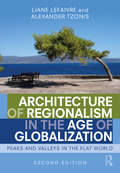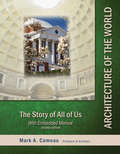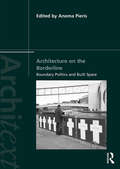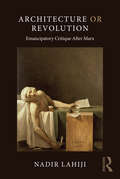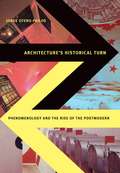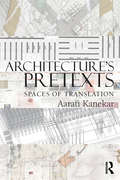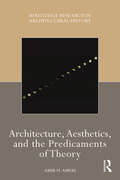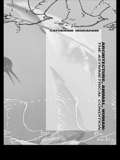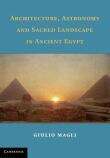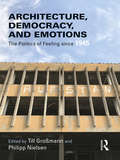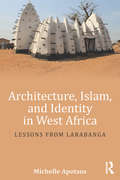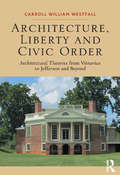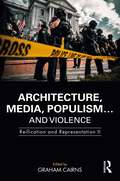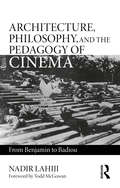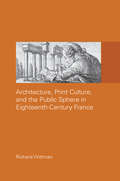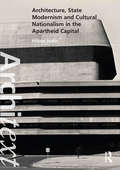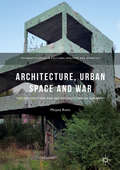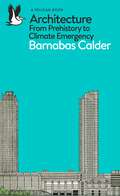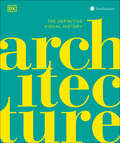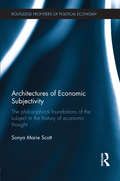- Table View
- List View
Architecture of Regionalism in the Age of Globalization: Peaks and Valleys in the Flat World
by Liane Lefaivre Alexander TzonisThis book remains the definitive introductory text on the theory and history of regionalist architecture in the context of globalization. It addresses issues of identity, diversity, community, inequality, geopolitics, and sustainability. From the authors who coined the concept of Critical Regionalism, this new edition enhances the understanding of the complex evolution of regionalism and its rival, unchecked globalization. Covering a rich selection of the most outstanding examples of design from all over the world, Liane Lefaivre and Alexander Tzonis, who introduced the concept of Critical Regionalism to architecture, present an enlightening, concise historical analysis of the endurance of regionalism and the ceaseless drive for globalization. New case studies include current cutting-edge projects in Japan, Africa, China, and the United States. Architecture of Regionalism in the Age of Globalization offers undergraduate and graduate students of architecture, geography, history, environmental studies, and other related fields an accessible, vivid, and scholarly perspective of this major conflict as it relates to the design and to the future of the human-made environment.
Architecture of the World: The Story of All of Us (2nd Edition)
by Mark A. ComeauJust as the design of architecture can be avant-garde while at the same time being reflective, the format contained herein offers a pictorially-centric layout while containing related briefs. As a text book that accompanies the lecture portion of a traditional “ground” course, the details are delivered in the classroom and they come in the form of a semester-long story. To see the figures, hear the stories, and “jot down” notes and highlights, is to retain; retain a visual memory of architecture and correlate the application it has to its cause to be built. <p><p>The author has taught Architecture of the World for almost two decades. Though several books are suggested as recommended readings, there has never been an assigned text book as no one book has been found to deliver the content in a way that parallels the author’s “contagious enthusiasm” for teaching history through stories and experiences. <p><p>The content of this book represents an ongoing accumulation of the author’s experiences, photographs, research, and of course - stories, as lived through travel-study around the world that he has led more than a thousand learners on. It is meant to be more of an album, a record, that along with the live lectures results in a semester-long story of the history of all of us!
Architecture on the Borderline: Boundary Politics and Built Space (Architext)
by Anoma PierisArchitecture on the Borderline interrogates space and territory in a turbulent present where nation-state borders are porous to a few but impermeable to many. It asks how these uneven and conflicted social realities are embodied in the physical and material conditions imagined, produced or experienced through architecture and urbanism. Drawing on historical, global examples, this rich collection of essays illustrates how empires, nations and cities expand their frontiers and contest boundaries, but equally how borderline identities of people and places influence or expose these processes. Empirical chapters covering Central Asia, the Asia Pacific region, the American continent, Europe and the Middle East offer multiple critical insights into the ways in which our spatial imagination is contingent on ‘border-thinking’; on the ways of being and navigating frontiers, boundaries and margins, the three themes used to organise their content. The underlying premise of the book is that sensitisation to border conditions can alter our understanding of the static physical spaces that service political or cultural ideologies, and that the view from the periphery opens up new ways of understanding sovereignty. In exploring these various spaces and their transformative subjectivities, this book also reveals the unrelenting precarity of contesting and living on the margins, and related spaces and discourses that are neglected or suppressed.
Architecture or Revolution: Emancipatory Critique After Marx
by Nadir LahijiBy linking building theory to the emancipatory project of critique advanced by radical thinkers in our time, this work investigates the key conceptual and historical elements that culminate in an emancipatory theory of building entitled: 'Toward a philosophy of shelter’. Taking Marx as its only resource, this work proceeds with the conviction that our era is contemporaneous to Marx’s historical era. This means ‘not judging the validity of Marx from the perspective of the historical situation’, but rather, ‘demonstrating the validity of a Marxian perspective for a singular historical situation’, as ours. This work will therefore translate this perspective into seeing the situation of architecture through the eyes of Marx. All those concerned with the predicament in our current condition in which architecture must play a major social role in upholding the universal value of what Alain Badiou calls 'generic humanity' will take an interest in this work. In particular, architects, critics, scholars, and students inside the field of architecture who would be seeking the application of this universal value to a new theory of building will be a welcoming audience for this work.
Architecture since 1400
by Kathleen James-ChakrabortyThe first global history of architecture to give equal attention to Western and non-Western structures and built landscapes, Architecture since 1400 is unprecedented in its range, approach, and insight. From Tenochtitlan&’s Great Pyramid in Mexico City and the Duomo in Florence to Levittown&’s suburban tract housing and the Bird&’s Nest Stadium in Beijing, its coverage includes the world&’s most celebrated structures and spaces along with many examples of more humble vernacular buildings. Lavishly illustrated with more than 300 photographs, plans, and interiors, this book presents key moments and innovations in architectural modernity around the globe. Deftly integrating architectural and social history, Kathleen James-Chakraborty pays particular attention to the motivations of client and architect in the design and construction of environments both sacred and secular: palaces and places of worship as well as such characteristically modern structures as the skyscraper, the department store, and the cinema. She also focuses on the role of patrons and addresses to an unparalleled degree the impact of women in commissioning, creating, and inhabiting the built environment, with Gertrude Jekyll, Lina Bo Bardi, and Zaha Hadid taking their place beside Brunelleschi, Sinan, and Le Corbusier. Making clear that visionary architecture has never been the exclusive domain of the West and recognizing the diversity of those responsible for commissioning, designing, and constructing buildings, Architecture since 1400 provides a sweeping, cross-cultural history of the built environment over six centuries.
Architecture's Appeal: How Theory Informs Architectural Praxis
by Marc J. Neveu Negin DjavaherianThis collection of previously unpublished essays from a diverse range of well-known scholars and architects builds on the architectural tradition of phenomenological hermeneutics as developed by Dalibor Veseley and Joseph Rykwert and carried on by David Leatherbarrow, Peter Carl and Alberto Pérez-Gómez. Taking an interdisciplinary approach and drawing on ideas from beyond the architectural canon, contributors including Kenneth Frampton, David Leatherbarrow, Juhani Pallasmaa, Karsten Harries, Steven Holl, Indra Kagis McEwen, Paul Emmons, and Louise Pelletier offer new insights and perspectives on questions such as the following: Given the recent fascination with all things digital and novel, what is the role of history and theory in contemporary architectural praxis? Is authentic meaning possible in a technological environment that is so global and interconnected? What is the nature and role of the architect in our shared modern world? How can these questions inform a new model of architectural praxis? Architecture's Appeal is a thought-provoking book which will inspire further scholarly inquiry and act as a basis for discussion in the wider field as well as graduate seminars in architectural theory and history.
Architecture's Historical Turn: Phenomenology and the Rise of the Postmodern
by Jorge Otero-PailosArchitecture&’s Historical Turn traces the hidden history of architectural phenomenology, a movement that reflected a key turning point in the early phases of postmodernism and a legitimating source for those architects who first dared to confront history as an intellectual problem and not merely as a stylistic question. Jorge Otero-Pailos shows how architectural phenomenology radically transformed how architects engaged, theorized, and produced history. In the first critical intellectual account of the movement, Otero-Pailos discusses the contributions of leading members, including Jean Labatut, Charles Moore, Christian Norberg-Schulz, and Kenneth Frampton. For architects maturing after World War II, Otero-Pailos contends, architectural history was a problem rather than a given. Paradoxically, their awareness of modernism&’s historicity led some of them to search for an ahistorical experiential constant that might underpin all architectural expression. They drew from phenomenology, exploring the work of Bachelard, Merleau-Ponty, Heidegger, and Ricoeur, which they translated for architectural audiences. Initially, the concept that experience could be a timeless architectural language provided a unifying intellectual basis for the stylistic pluralism that characterized postmodernism. It helped give theory—especially the theory of architectural history—a new importance over practice. However, as Otero-Pailos makes clear, architectural phenomenologists could not accept the idea of theory as an end in itself. In the mid-1980s they were caught in the contradictory and untenable position of having to formulate their own demotion of theory. Otero-Pailos reveals how, ultimately, the rise of architectural phenomenology played a crucial double role in the rise of postmodernism, creating the antimodern specter of a historical consciousness and offering the modern notion of essential experience as the means to defeat it.
Architecture's Pretexts: Spaces of Translation
by Aarati KanekarThe aim of this book is to expose readers to architecture’s pretexts that include literary narratives, film, theatre, painting, music, and ritual, as a bridge between diverse intellectual territories and architecture. It introduces a selection of seminal modern and contemporary architectural projects, their situation within the built environment, and their intellectual and formal situation/context as pretexts and design paradigms. Connections between diverse bodies of information will be cultivated along with the ability to posit consequential relationships for the production of architecture. Architecture’s Pretexts seeks to cultivate a vision for architecture that sponsors operative links between the discipline of architecture and those outside of architecture. Exploring the works of various architects including Guiseppe Terragni, Peter Eisenman, Peter Zumthor, Perry Kulper and Smout Allen, and Rem Koolhaas, this book provides the framework to understanding architecture through the lens of art. Key concepts discussed are: allegories, diagrams, form, material, montage, movement, musical ratios, narrative sequence and representation. A valuable tool, with over 75 black and white illustrations, for students and professionals interested in interdisciplinary methods of design thinking.
Architecture, Aesthetics, and the Predicaments of Theory (Routledge Research in Architectural History)
by Amir H AmeriArchitecture, Aesthetics, and the Predicaments of Theory offers a critical analysis of the methodological constants and shared critical strategies in the history of theoretical discourse on Western architecture. Central to these constants is the persistent role of aesthetics as a critical tool for the delimitation of architecture. This book analyzes the unceasing critical role aesthetics is given to play in the discourse of architecture. The book offers a close and critical reading of three seminal texts from three different periods in the history of theoretical discourse on Western architecture—the Renaissance, the Enlightenment, and 19th-century Romanticism. The first text is Leone Battista Alberti's Ten Books on Architecture of 1452, the next Marc-Antoine Laugier’s An Essay on Architecture of 1753, and last, John Ruskin’s The Seven Lamps of Architecture of 1849. Additional influential texts from, among others, the 20th and 21st centuries are engaged with along the way to locate and contextualize the arguments within the broader discursive tradition of Western architecture. The book will interest scholars and students of architecture, architectural history and theory, as well as scholars and students of cultural studies, aesthetic philosophy, art history, literary criticism, and related disciplines.
Architecture, Animal, Human: The Asymmetrical Condition
by Catherine T. IngrahamThis book looks at specific instances in the Renaissance, Enlightenment and our own time when architectural ideas and ideas of biological life come into close proximity with each other. These convergences are fascinating and complex, offering new insights into architecture and its role. Establishing architecture as a product of the ascendancy of the position of human life, the author shows here that while architecture is dependent on life forces for its existence, at the same time it must be, at some level, indifferent to the life within it. Life, for its part, privileges itself above all else, and seeks to continuously expand its field of expression. This, then, is the asymmetrical condition, and to understand it is to gain important new theoretical perspectives into the nature of architecture.
Architecture, Astronomy and Sacred Landscape in Ancient Egypt
by Giulio MagliThis book examines the interplay between astronomy and dynastic power in the course of ancient Egyptian history, focusing on the fundamental role of astronomy in the creation of the pyramids and the monumental temple and burial complexes. Bringing to bear the analytical tools of archaeoastronomy, a set of techniques and methods that enable modern scholars to better understand the thought, religion, and science of early civilizations, Giulio Magli provides in-depth analyses of the pyramid complexes at Giza, Abusir, Saqqara, and Dahshur, as well as of the Early Dynastic necropolis at Abydos and the magnificent new Kingdom Theban temples. Using a variety of data retrieved from study of the sky and measurements of the buildings, he reconstructs the visual, symbolic, and spiritual world of the ancient Egyptians and thereby establishes an intimate relationship among celestial cycles, topography, and architecture. He also shows how they were deployed in the ideology of the pharaoh's power in the course of Egyptian history.
Architecture, Democracy and Emotions: The Politics of Feeling since 1945
by Till Großmann Philipp NielsenAfter 1945 it was not just Europe’s parliamentary buildings that promised to house democracy: hotels in Turkey and Dutch shopping malls proposed new democratic attitudes and feelings. Housing programs in the United Kingdom, the United States, and the Soviet Union were designed with the aim of creating new social relations among citizens and thus better, more equal societies. Architecture, Democracy, and Emotions focuses on these competing promises of consumer democracy, welfare democracy, and socialist democracy. Spanning from Turkey across Eastern and Western Europe to the United States, the chapters investigate the emotional politics of housing and representation during the height of the Cold War, as well as its aftermath post-1989. The book assembles detailed research on how the claims and aspirations of being "democratic" influenced the affects of architecture, and how these claims politicized space. Architecture, Democracy, and Emotions contributes to the study of Europe’s "democratic age" beyond Cold War divisions without diminishing political differences. The combination of an emotional history of democracy with an architectural history of emotions distinguishes the book’s approach from other recent investigations into the interconnection of mind, body, and space.
Architecture, Islam, and Identity in West Africa: Lessons from Larabanga
by Michelle ApotsosArchitecture, Islam, and Identity in West Africa shows you the relationship between architecture and Islamic identity in West Africa. The book looks broadly across Muslim West Africa and takes an in-depth study of the village of Larabanga, a small Muslim community in Northern Ghana, to help you see how the built environment encodes cultural history through form, material, and space, creating an architectural narrative that outlines the contours of this distinctive Muslim identity. Apotsos explores how modern technology, heritage, and tourism have increasingly affected the contemporary architectural character of this community, revealing the village’s current state of social, cultural, and spiritual flux. More than 60 black and white images illustrate how architectural components within this setting express the distinctive narratives, value systems, and realities that make up the unique composition of this Afro-Islamic community.
Architecture, Liberty and Civic Order: Architectural Theories from Vitruvius to Jefferson and Beyond
by Carroll William WestfallThis book brings to light central topics that are neglected in current histories and theories of architecture and urbanism. These include the role of imitation in earlier centuries and its potential role in present practice; the necessary relationship between architecture, urbanism and the rural districts; and their counterpart in the civil order that builds and uses what is built. The narrative traces two models for the practice of architecture. One follows the ancient model in which the architect renders his service to serve the interests of others; it survives and is dominant in modernism. The other, first formulated in the fifteenth century by Leon Battista Alberti, has the architect use his talent in coordination with others to contribute to the common good of a republican civil order that seeks to protect its own liberty and that of its citizens. Palladio practiced this way, and so did Thomas Jefferson when he founded a uniquely American architecture, the counterpart to the nation’s founding. This narrative gives particular emphasis to the contrasting developments in architecture on the opposite sides of the English Channel. The book presents the value for clients and architects today and in the future of drawing on history and tradition. It stresses the importance, indeed, the urgency, of restoring traditional practices so that we can build just, beautiful, and sustainable cities and rural districts that will once again assist citizens in living not only abundantly but also well as they pursue their happiness.
Architecture, Media, Populism… and Violence: Reification and Representation II
by Graham CairnsThe ‘Storming of the Capitol’ was, for many, the culminating media performance of the four-year presidency of Donald Trump. His presidency and its ‘final act’, bore all the hallmarks of a 21st century form of populism and media-politico spectacle that may yet come to dominate the political scene in the US, and worldwide, for years to come. The questions that such events raise are complex, varied and operative across a multitude of disciplines. This book engages with these vexed questions in the broad fields of politics and media, but does so, uniquely, through the prism of architecture. This book does not, however, limit its view to the recent events in Washington DC or the United States. Rather, it seeks to use those events as the starting point for a critique of architecture in the tapestry of mediated forms of protest and ‘political action’ more generally. Each chapter draws on case studies from across timeframes and across nations. The book sharpens our critique of the relationship between direct political action, its media representation and the role it assigns to architecture – as played out globally in the age of mass media. In doing so, it opens up broader debates about the past, present and future roles of architecture as a political tool in the context of international political systems now dominated by changing and unpredictable uses of media, and characterised by an increasingly volatile and at times violent form of political activism. It is essential reading for any student or researcher engaging with these questions.
Architecture, Opportunity, and Conflict in Eighteenth-Century Sicily: Rebuilding after Natural Disaster (Visual and Material Culture, 1300-1700)
by Martin NixonThe catastrophic Sicilian earthquake of 1693 led to the rebuilding of over 60 towns in the island's south-west. The rebuilding extended into the eighteenth century and gave opportunities for the reassertion and the transformation of power relations. Although eight of the towns are now protected by UNESCO, the remarkable architecture resulting from this rebuilding is little known outside Sicily. This is the first book-length study in English of this interesting area of early modern architecture. Rather than seek to address all of the towns, five case studies discuss key aspects of the rebuilding by approaching the architecture from different scales, from that of a whole town to parts of a town, or single buildings, or parts of buildings and their decoration. Each case study also investigates a different theoretical assumption in architecture, including ideas of the Baroque, rational planning, and the relegation of decoration in architectural discourse.
Architecture, Philosophy, and the Pedagogy of Cinema: From Benjamin to Badiou
by Nadir LahijiPhilosophers on the art of cinema mainly remain silent about architecture. Discussing cinema as ‘mass art’, they tend to forget that architecture, before cinema, was the only existing ‘mass art’. In this work author Nadir Lahiji proposes that the philosophical understanding of the collective human sensorium in the apparatus of perception must once again find its true training ground in architecture. Building art puts the collective mass in the position of an ‘expert critic’ who identifies themselves with the technical apparatus of architecture. Only then can architecture regain its status as ‘mass art’ and, as the book contends, only then can it resume its function as the only ‘artform’ that is designed for the political pedagogy of masses, which originally belonged to it in the period of modernity before the invention of cinema.
Architecture, Print Culture and the Public Sphere in Eighteenth-Century France (The Classical Tradition in Architecture)
by Richard WittmanThis book focuses on the complex ways in which architectural practice, theory, patronage, and experience became modern with the rise of a mass public and a reconfigured public sphere between the end of the seventeenth century and the French Revolution. Presenting a fresh theoretical orientation and a large body of new primary research, this book offers a new cultural history of virtually all the major monuments of eighteenth-century Parisian architecture, with detailed analyses of the public debates that erupted around such Parisian monuments as the east facade of the Louvre, the Place Louis XV [the Place de la Concorde], and the church of Sainte-Genevieve [the Pantheon]. Depicting the passage of architecture into a mediatized public culture as a turning point, and interrogating it as a symptom of the distinctly modern configuration of individual, society, and space that emerged during this period, this study will interest readers well beyond the discipline of architectural history.
Architecture, State Modernism and Cultural Nationalism in the Apartheid Capital (Architext)
by Hilton JudinThis book is the first comprehensive investigation of the architecture of the apartheid state in the period of rapid economic growth and political repression from 1957 to 1966 when buildings took on an ideological role that was never remote from the increasingly dominant administrative, legislative and policing mechanisms of the regime. It considers how this process reflected the usurpation of a regional modernism and looks to contribute to wider discourses on international postwar modernism in architecture. Buildings in Pretoria that came to embody ambitions of the apartheid state for industrialisation and progress serve as case studies. These were widely acclaimed projects that embodied for apartheid officials the pursuit of modernisation but carried latent apprehensions of Afrikaners about their growing economic prospects and cultural estrangement in Africa. It is a less known and marginal story due to the dearth of material and documents buried in archives and untranslated documents. Many of the documents, drawings and photographs in the book are unpublished and include classified material and photographs from the National Nuclear Research Centre, negatives of 1960s from Pretoria News and documents and pamphlets from Afrikaner Broederbond archives. State architecture became the most iconic public manifestation of an evolving expression of white cultural identity as a new generation of architects in Pretoria took up the challenge of finding form to their prospects and beliefs. It was an opportunistic faith in Afrikaners who urgently needed to entrench their vulnerable and contested position on the African continent. The shift from provincial town to apartheid capital was swift and relentless. Little was left to stand in the way of the ambitions and aim of the state as people were uprooted and forcibly relocated, structures torn down and block upon block of administration towers and slabs erected across Pretoria. This book will be of great interest to students and scholars of architectural history as well as those with an interest in postcolonial studies, political science and social anthropology.
Architecture, Urban Space and War: The Destruction and Reconstruction of Sarajevo (Palgrave Studies in Cultural Heritage and Conflict)
by Mirjana RisticThis book investigates architectural and urban dimensions of the ethnic-nationalist conflict in Sarajevo, the capital of Bosnia and Herzegovina, during and after the siege of 1992–1995. Focusing on the wartime destruction of a portion of the cityscape in central Sarajevo and its post-war reconstruction, re-inscription and memorialization, the book reveals how such spatial transformations become complicit in the struggle for reconfiguration of the city’s territory, boundaries and place identity. Drawing on original research, the study highlights the capacities of architecture and urban space to mediate terror, violence and resistance, and to deal with heritage of the war and act a catalyst for ethnic segregation or reconciliation. Based on a multi-disciplinary methodological approach grounded in architectural and urban theory, the spatial turn in critical social theory and assemblage thinking, as well as techniques of spatial analysis, in particular morphological mapping, the book provides an innovative spatial framework for analyzing the political role of contemporary cities.
Architecture: A Visual History
by Jonathan GlanceyDiscover the beautiful details, principal elements, and decorative features of every architectural style, from the Great Pyramid of Giza, Machu Picchu, and the Colosseum to the Sydney Opera House, the Gherkin, and Burj Khalifa. Architecture offers a truly worldwide look at historical and contemporary buildings, with breathtaking photography and intriguing cross-sections to enhance your view. See how and why certain features were common in specific time periods and how these amazing buildings have stood the test of time.
Architecture: From Prehistory To Post Modernity
by Isabelle Hyman Marvin TrachtenbergMoving back and forth between the long view of historical trends and close-ups on major works and crucial architectural themes, this lavishly-illustrated survey explains specific qualities of periods in depth and the complex illuminating differences between them in social, intellectual, and aesthetic terms.
Architecture: From Prehistory to Climate Emergency (Pelican Books)
by Barnabas CalderA groundbreaking history of architecture told through the relationship between buildings and energyThe story of architecture is the story of humanity. The buildings we live in, from the humblest pre-historic huts to today's skyscrapers, reveal our priorities and ambitions, our family structures and power structures. And to an extent that hasn't been explored until now, architecture has been shaped in every era by our access to energy, from fire to farming to fossil fuels.In this ground-breaking history of world architecture, Barnabas Calder takes us on a dazzling tour of some of the most astonishing buildings of the past fifteen thousand years, from Uruk, via Ancient Rome and Victorian Liverpool, to China's booming megacities. He reveals how every building - from the Parthenon to the Great Mosque of Damascus to a typical Georgian house - was influenced by the energy available to its architects, and why this matters.Today architecture consumes so much energy that 40% of the world's greenhouse gas emissions come from the construction and running of buildings. If we are to avoid catastrophic climate change then now, more than ever, we need beautiful but also intelligent buildings, and to retrofit - not demolish - those that remain. Both a celebration of human ingenuity and a passionate call for greater sustainability, this is a history of architecture for our times.
Architecture: The Definitive Visual Guide (DK Definitive Cultural Histories)
by DKFrom ancient dwellings to modern high-tech skyscrapers, discover everything there is to know about the history of architecture worldwide.Covering over 6,000 years of human history, Architecture charts the most important developments in building materials, technology, design, and the social changes that have shaped the architectural landscape. Explore every significant architectural period and style in depth through critical examples. Take a tour of some of the world&’s most iconic buildings, beautifully illustrated with brilliant photography and specially commissioned CGI artworks. Dive deep into the pages of this inspiring architecture book to discover:- An innovative approach to the story of architecture using iconic examples. - Explores buildings throughout history and across the world.- A combination of creative photography and specially commissioned CGI artworks to analyze every significant architectural style.- Profiles of the latest developments in architectural practice, including &“green&” technology, such as living façades.- Published in association with the Smithsonian Institution in the US.- Optional 56-page reference section profiles key architects and contains profiles of additional important buildings.Find out why so many ancient Roman structures have withstood the test of time. Learn how the soaring ceilings of Gothic cathedrals are held up. And discover the architectural innovations that are helping to combat climate change. Architecture is the perfect book for anyone fascinated by the built world – its visual character and the factors that have formed it – and who wants to understand more.
Architectures of Economic Subjectivity: The Philosophical Foundations of the Subject in the History of Economic Thought (Routledge Frontiers of Political Economy)
by Sonya ScottThe history of European economic thought has long been written by those seeking to prove or disprove the truth-value of the theories they describe. This work takes a different approach. It explores the philosophical groundwork of the theoretical structure within which economic subjects are presented. Demonstrating how the subjects of economic texts tend to be defined in and through their relationship to knowledge, this study addresses the epistemological constitution of subjectivity in economic thought.
